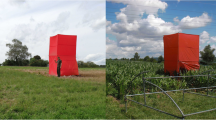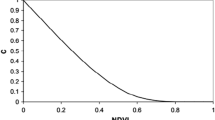Abstract
Purpose
Rain-induced overland flow involves the detachment of soil particles by raindrop impact and the transportation by the resultant overland flow. The purpose of this study was to investigate the relationship between sediment concentration and different hydraulic parameters including flow depth, flow velocity, shear stress, stream power, and unit stream power. The effects of soil particle size distribution, rain intensity, and slope steepness on measured sediment concentration in rain-induced sheet flow were also examined.
Materials and methods
Two arid land soils with different particles size distributions (D2mm and D4.75mm) were subjected to simulated rains using a detachment tray under infiltration conditions. Two rain intensities of 57 and 80 mm h−1 were simulated on slope gradients ranging from 0.5 to 20 %, resulting in rain-induced overland flows. After pre-wetting each soil, the sediment-laden overland flow was sampled at several time intervals (2, 5, 15, 20, 30, and 40 min) and the sediment concentration was determined. Different hydraulic parameters including flow depth, flow velocity, shear stress, stream power, and unit stream power were measured. The hydraulic parameters were used to model the sediment concentration, and the model performance was evaluated.
Results and discussion
The result showed that the measured sediment concentration was greater in the higher rainfall intensity and at steeper slopes. With increasing slope steepness, sediment concentration increased from 4.3 to 15.5 kg m−3 and from 3.8 to 12.5 kg m−3 for soils D2mm and D4.75mm, respectively. There was a direct relationship between sediment concentration and the rain-induced flow velocity, shear stress, stream power, and unit stream power. Nevertheless, the values of sediment concentration increased as flow depth decreased on steeper slopes. Also, sediment concentration was lower in the soil containing larger aggregates than in the finer soil. The hydraulic parameters tended to overestimate low amounts of sediment concentration and underestimate high values.
Conclusions
In general, the accuracy of the hydraulic parameters in predicting sediment concentration was: flow velocity > stream power > shear stress > unit stream power > flow depth. Flow velocity was the best predictor of sediment concentration with a linear relationship, whereas the other parameters showed nonlinear relationships. This study revealed that rain-induced sediment concentration at small scales can be modeled precisely on the basis of the flow velocity parameter.







Similar content being viewed by others
References
Assouline S (2004) Rainfall-induced soil surface sealing: a critical review of observations, conceptual models, and solutions. Vadose Zone J 3:570–591
Bryan RB (1979) The influence of slope angle on soil entrainment by sheetwash and rainsplash. Earth Surf Process 4:43–58
Bryan RB (2000) Soil erodibility and processes of water erosion on hillslope. Geomorphology 32:385–415
Cao L, Zhang K, Dai H, Liang Y (2013) Modeling interrill erosion on unpaved roads in the loess plateau of China. Land Degrad Dev. doi:10.1002/ldr.2253
Cerdà A (1996) Soil aggregate stability in three Mediterranean environments. Soil Technol 9:133–141
Cerdà A (1997) Rainfall drop size distribution in Western Mediterranean Basin, València, Spain. Catena 30:169–182
Cerdà A, Doerr SH (2007) Soil wettability, runoff and erodibility of major dry-Mediterranean land use types on calcareous soils. Hydrol Process 21:2325–2336
Cerdà A, Hooke J, Romero-Diaz A, Montanarella L, Lavee H (2010) Soil erosion on Mediterranean type-ecosystems. Land Degrad Dev 21:71–74
Defersha MB, Melesse AM (2012) Effect of rainfall intensity, slope and antecedent moisture content on sediment concentration and sediment enrichment ratio. Catena 90:47–52
Deng ZQ, Lima JLD, Jung HS (2008) Sediment transport rate-based model for rainfall-induced soil erosion. Catena 76:54–62
Dlamini P, Orchard C, Jewitt G, Lorentz S, Titshall L, Chaplot V (2011) Controlling factors of sheet erosion under degraded grassland in the sloping land of KwaZulu-Natal, South Africa. Agric Water Manag 98:1711–1718
Dunne T, Malmon DV, Mudd SM (2010) A rain splash transport equation assimilating field and laboratory measurements. J Geophys Res Earth Surf 115, F01001. doi:10.1029/2009JF001302
Fox DM, Bryan RB (1999) The relationship of soil loss by interrill erosion to slope gradient. Catena 38:211–222
Fu S, Liu B, Liu H, Xu L (2011) The effect of slope on interrill erosion at short slopes. Catena 84:29–34
Gabet EJ, Dunne T (2003) Sediment detachment by rain power. Water Resour Res 39:1–12
García-Orenes F, Cerdà A, Mataix-Solera J, Guerrero C, Bodí MB, Arcenegui V, Zornoza R, Sempere JG (2009) Effects of agricultural management on surface soil properties and soil-water losses in eastern Spain. Soil Tillage Res 106:117–123
Grismer M (2012) Standards vary in studies using rainfall simulators to evaluate erosion. Calif Agric 66:102–107
Hall MJ (1970) Use of the stain method in determining the drop-size distributions of coarse liquid sprays. Trans ASAE 41:33–37
Iserloh T, Ries JB, Cerdà A, Echeverría MT, Fister W, Geißler C, Kukn NJ, Leon FJ, Peters P, Schindewolf M, Schmidt J, Scholten T, Seeger M (2012) Comparative measurements with seven rainfall simulators on uniform bare fallow land. Z Geomorphol 57:11–26
Kemper WD, Rosenau RC (1986) Aggregate stability and size distribution. In: Klute A (ed) Methods of soil analysis. ASA and SSSA, Madison, pp 425–442
Kinnell PIA (2000) The effect of slope length on sediment concentration associated with side-slope erosion. Soil Sci Soc Am J 64:1004–1008
Kinnell PIA (2003) Event erosivity factor and errors in erosion predictions by some empirical models. Aust J Soil Res 41:991–1003
Kinnell PIA (2005) Raindrop impact induced erosion processes and prediction: a review. Hydrol Process 19:2815–2844
Kinnell PIA (2009) The impact of slope length on the discharge of sediment by rain impact induced saltation and suspension. Earth Surf Process Landf 34:1393–1407
Kinnell PIA (2010) Comment on a new splash and sheet erosion equation for range lands. Soil Sci Soc Am J 74:340–341
Kuhn NJ, Armstrong EK, Ling AC, Connolly KL, Heckrath G (2012) Interrill erosion of carbon and phosphorus from conventionally and organically farmed Devon silt soils. Catena 91:94–103
Le Bissonnais Y (1995) Soil characteristics and aggregate stability. In: Agassi M (ed) Soil erosion, conservation and rehabilitation. CRC Press, pp 41–60
Leh M, Bajwa S, Chaubey I (2013) Impact of land use change on erosion risk: an integrated remote sensing geographic information system and modeling methodology. Land Degrad Dev 24:409–421
Ligonja PJ, Shrestha RP (2013) Soil erosion assessment in Kondoa eroded area in Tanzania using universal soil loss equation, geographic information system and socioeconomic approach. Land Degrad Dev. doi:10.1002/ldr.2215
Mahmoodabadi M, Ahmadbeygi B (2011) Effect of some physical and chemical properties of soil on aggregate stability in some cultivation systems. J Soil Manag Sustain Prod 1:61–79
Mahmoodabadi M, Ahmadbeygi B (2013) Effect of primary particle size distribution on aggregate stability at different size classes. Water Soil Sci 23:207–219
Mahmoodabadi M, Cerda A (2013) WEPP calibration for improved predictions of interrill erosion in semi-arid to arid environments. Geoderma 204–205:75–83
Mahmoodabadi M, Rouhipour H (2011) Study on process changes in some indices of soil erodibility and deposibility using rainfall simulator. J Water Soil Conserv 18:145–166
Mahmoodabadi M, Rouhipour H, Arabkhedri M, Rafahi HG (2007) Intensity calibration of SCWMRI rainfall and erosion simulator. J Watershed Manag Sci Eng 1:39–50
Mahmoodabadi M, Ghadiri H, Bofu Y, Rose C (2014a) Morpho-dynamic quantification of flow-driven rill erosion parameters based on physical principles. J Hydrol 514:328–336
Mahmoodabadi M, Ghadiri H, Rose C, Bofu Y, Rafahi H, Rouhipour H (2014b) Evaluation of GUEST and WEPP with a new approach for the determination of sediment transport capacity. J Hydrol 513:413–421
Mandal D, Sharda VN (2013) Appraisal of soil erosion risk in the Eastern Himalayan region of India for soil conservation planning. Land Degrad Dev 24:430–437
Martinez-Mena M, Castillo V, Albaladejo J (2002) Relations between interrill erosion processes and sediment particle size distribution in a semiarid Mediterranean area of SE of Spain. Geomorphology 45:261–275
Nearing MA (1998) Why soil erosion models over-predict small soil losses and underpredict large soil losses. Catena 32:15–22
Nearing MA, Norton LD, Bulgakov DA, Larionov GA (1997) Hydraulics and erosion in eroding rills. Water Resour Res 33:865–876
Page AL, Miller RH, Jeeney DR (1992) Methods of soil analysis, Part 2, Chemical and mineralogical properties. SSSA. Pub., Madison, p 1159
Palacio RG, Bisigato AJ, Bouza PJ (2014) Soil erosion in three grazed plant communities in northeastern Pataginia. Land Degrad Dev 25:594–603
Parsons AJ, Abrahams AD, Wainwright J (1994) On determining resistance to interrill overland flow. Water Resour Res 30:3515–3521
Proffitt APB, Hairsine PB, Rose CW (1993) Modeling soil erosion by overland flow: application over a range of hydraulic conditions. Trans ASAE 36:1743–1753
Shi ZH, Fang NF, Wu FZ, Wang L, Yue BJ, Wu GL (2012a) Soil erosion processes and sediment sorting associated with transport mechanisms on steep slopes. J Hydrol 454–455:123–130
Shi ZH, Yue BJ, Wang L, Fang NF, Wang D, Wu FZ (2012b) Effects of mulch cover rate on interrill erosion processes and the size selectivity of eroded sediment on steep slopes. Soil Sci Soc Am J 77:257–267
Shih HM, Yang CT (2009) Estimating overland flow erosion capacity using unit stream power. Int J Sediment Res 24:46–62
Sirjani E, Mahmoodabadi M (2012a) Effects of sheet flow rate and slope gradient on sediment load. Arab J Geosci 7:203–210
Sirjani E, Mahmoodabadi M (2012b) Study on flow erosivity indicators for predicting soil detachment rate at low slopes. Int J Agric Sci Res Technol 2:55–61
Tiwari AK, Risse LM, Nearing MA (2000) Evaluation of WEPP and its comparison with USLE and RUSLE. Trans ASAE 43:1129–1135
Trout TJ, Neibling WH (1993) Erosion and sedimentation processes on irrigated fields. J Irrig Drain Eng 119:947–963
Van Dijk AIJM, Bruijnzeel M, Eisma EH (2003) A methodology to study rain splash and wash processes under natural rainfall. Hydrol Process 17:153–167
Walkley A, Black IA (1934) An examination of the degtjareff method for determining soil organic matter, and proposed modification of the chromic acid titration method. Soil Sci 37:29–38
Wang YQ, Shao MA (2013) Spatial variability of soil physical properties in a region of the loess plateau of PR China subject to wind and water erosion. Land Degrad Dev 24:296–304
Wuddivira MN, Stone RJ, Ekwue EI (2009) Clay, organic matter and wetting effects on splash detachment and aggregate breakdown under intense rainfall. Soil Sci Soc Am J 73:226–232
Yu B (2003) A unified framework for water erosion and deposition equations. Soil Sci Soc Am J 67:251–257
Yuill BT, Gasparini NM (2011) Hydrologic controls on wash load sediment concentrations within a low-ordered, ephemeral watershed. J Hydrol 410:73–83
Zhang GS, Chan KY, Oates A, Heenan DP, Huang GB (2007) Relationship between soil structure and runoff/soil loss after 24 years of conservation tillage. Soil Tillage Res 92:122–128
Zhao G, Mu X, Wen Z, Wang F, Gao P (2013) Soil erosion, conservation, and eco-environment changes in the Loess Plateau of China. Land Degrad Dev 24:499–510
Ziadat FM, Taimeh AY (2013) Effect of rainfall intensity, slope and land use and antecedent soil moisture on soil erosion in an arid environment. Land Degrad Dev 24:582–590
Author information
Authors and Affiliations
Corresponding author
Additional information
Responsible editor: Nikolaus Kuhn
Rights and permissions
About this article
Cite this article
Arjmand Sajjadi, S., Mahmoodabadi, M. Sediment concentration and hydraulic characteristics of rain-induced overland flows in arid land soils. J Soils Sediments 15, 710–721 (2015). https://doi.org/10.1007/s11368-015-1072-z
Received:
Accepted:
Published:
Issue Date:
DOI: https://doi.org/10.1007/s11368-015-1072-z




